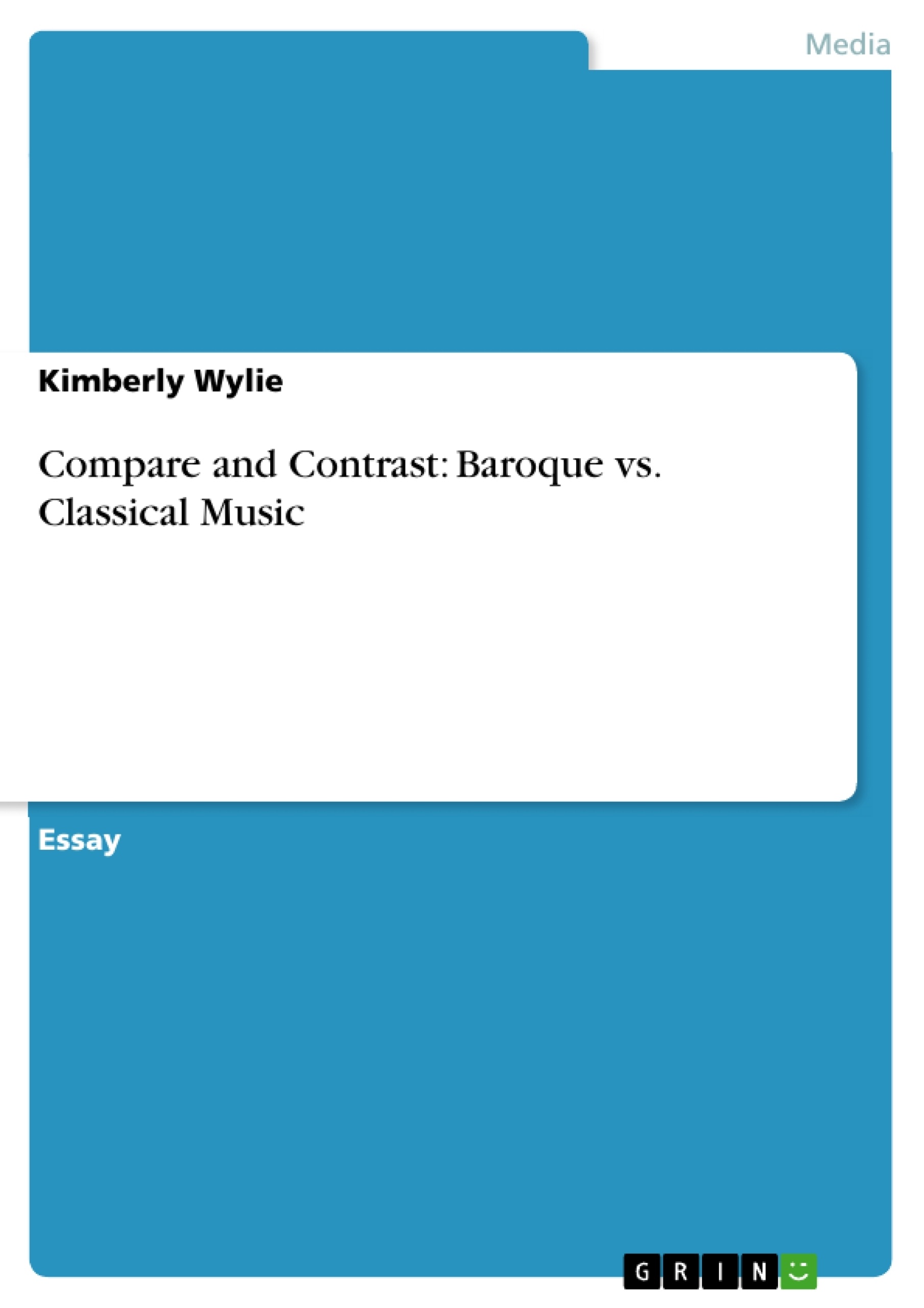At first glance, the Baroque music period and Classical music periods seem to be very much alike. They do, in fact, have many similarities, for instance, the same basic orchestral and chamber ensembles. However, by carefully analyzing each period, distinct differences can be found. The word ‘Baroque’ comes from the Italian word barocco, which literally translates to bizarre, however some feel that when dealing with the arts, exuberant is closer to the aim of the translation, and exuberant is a word that perfectly fits this style of music. Although Baroque was first used to describe ornately decorated buildings in Austria and Germany, it quickly became used to describe a similarly ornate period of music.
Compare and Contrast: Baroque vs. Classical Music
At first glance, the Baroque music period and Classical music periods seem to be very much alike. They do, in fact, have many similarities, for instance, “the same basic orchestral and chamber ensembles are used” (“From Baroque”, n.d.) in both periods. However, by carefully analyzing each period, distinct differences can be found.
The word ‘Baroque’ comes from the Italian word barocco, which literally translates to bizarre, however some feel that when dealing with the arts, exuberant is closer to the aim of the translation, and exuberant is a word that perfectly fits this style of music. Although Baroque was first used to describe ornately decorated buildings in Austria and Germany, it quickly became used to describe a similarly ornate period of music.
Named the Godfather of Baroque music, Italy’s “Giulio Cesare Monteverdi coined the term secunda prattica in the preface to his brother Claudio’sScherzi musicaliof 1607,” (Smith, 1996) issuing in the Baroque period. This prolific period would last for the next one hundred and fifty years. The secunda prattica, or second practice in English, referred to the advancement of compositional practice from the Renaissance era.
During the Renaissance period, composers strived to achieve balance in a piece between consonance and dissonance. Although Baroque too desired that both the harmonious and disharmonious combinations be balanced, it did not place the same emphasis on this desire as the previous Renaissance period or the coming Classical period. Baroque took music further, relying heavily on a fundamental bass line and delving deeply into the portraying of emotions.
Composers of this era used basso continuo as a mainstay in their work. Smith states,
the score of a continuo part, known as figured bass, consisted of a bass line accompanied by numbers (figures) representing the remaining pitches of each chord. The bass line was played by a sustaining low-pitch instrument, typically cello or bassoon, while the figures were “realized” by a chording instrument such as the harpsichord, organ or lute. (1996)
Improvisation and ornamentation was expected and encouraged in each piece. In Johann Sebastian Bach’sBrandenburg ConcertoNo. 4, basso continuo is gloriously exemplified with the harpsichord reinforcing the bass line.
In an effort by the Florentine Camarata, 16th-century composers and teachers from Florence, Italy, “to restore what they perceived to be the pure word-to-music relationships advocated by classical Greek philosophers such as Plato” (Smith, 1996) the “Doctrine of Affections” was developed. This doctrine was used in later centuries as the base for the belief that a composition was not merely a piece of music, but the actual tangible embodiment of emotions, a language of feelings for composers to speak with. In 1996, Smith states, “It was believed, for example, that a lamento bass was the palpable expression of sadness, while a rapidly rising sequence of thirds was the opposite – euphoria.” In Johann Sebastian Bach’sBrandenburg ConcertoNo. 5 one can feel how this concept is utilized. A listener clearly feels Bach’s conveyance of emotion in the piece.
The concerto and sonata saw their development during the Baroque period, that coupled with the creation of new instruments, especially wind, made this period very exciting. Composers experimented with their newfound tools, and instruments found their way to center stage often replacing vocals, or at the least sharing the spotlight equally. The violin was the string instrument of choice during this period.
As the 18th century waned, Western Europe was changing. The Industrial Revolution had begun to increase productivity. The philosophy of ‘Enlightenment’ emphasized the importance of a person’s rights and responsibility to mold their world. And, the political ideals of the Republican Government took hold leading to both the American and French Revolutions. In addition, musical “preferences moved toward simpler harmonies and more transparent textures as well as a tendency toward instrumental music.” (Zychowicz, 1996) As wealth and free time increased in the general populace, thanks mostly to the Industrial Revolution, it became acceptable to simply listen to music for the pure enjoyment of doing such. By the early 19th century Classical music dominated throughout Western Europe.
[...]
- Arbeit zitieren
- Kimberly Wylie (Autor:in), 2003, Compare and Contrast: Baroque vs. Classical Music, München, GRIN Verlag, https://www.grin.com/document/56628
-

-

-

-
Laden Sie Ihre eigenen Arbeiten hoch! Geld verdienen und iPhone X gewinnen. -

-
Laden Sie Ihre eigenen Arbeiten hoch! Geld verdienen und iPhone X gewinnen. -

-
Laden Sie Ihre eigenen Arbeiten hoch! Geld verdienen und iPhone X gewinnen. -

-
Laden Sie Ihre eigenen Arbeiten hoch! Geld verdienen und iPhone X gewinnen. -

-
Laden Sie Ihre eigenen Arbeiten hoch! Geld verdienen und iPhone X gewinnen.

